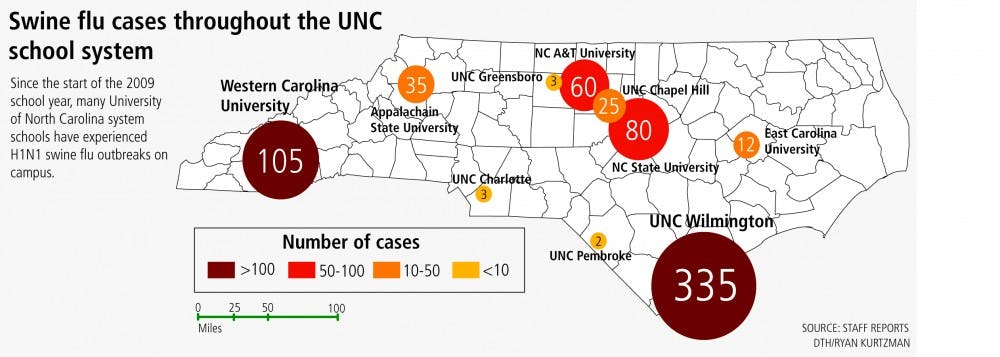Clarification: The graphic accompanying this article excludes several schools that do not have any reported cases of H1N1: UNC-Asheville, Fayetteville State University, Winston-Salem State University, N.C. School of Science and Math, N.C. School of the Arts and N.C. Central University. Officials at the other UNC-system school, Elizabeth City State University, could not be reached.
UNC-Wilmington has recorded 335 cases of H1N1 since Aug. 18, the start of their fall semester — more than any university in the state.
The magnitude of the outbreak across the state has prompted a change to federal policy that serves as a guide for the UNC system’s policy.
When H1N1, commonly known as swine flu, first appeared on campuses last spring, the Centers for Disease Control and Prevention told schools to submit students’ test results to state labs to determine if they had the virus.
After most of the specimens tested positive for H1N1, the CDC changed its policy — it now assumes that every student with flu-like symptoms has the H1N1 virus.
“The reason a new policy is being implemented is that labs were getting overwhelmed with test results — the vast majority of which were positive,” said Brent Herron, the associate vice president of Campus Safety and Emergency Operations for the UNC system.
Now when students present flu-like symptoms, the system’s policy recommends that they isolate themselves in dorm rooms or at home — away from public places where the virus can spread.
The new policy stresses prevention to ensure more students don’t continue to become infected.
UNC-W’s number of H1N1 cases has started levelling off after a drastic spike in cases since classes began.
Last week alone, 273 students contracted what is suspected to be the virus. However, that number only increased by 62 in the next four days.
With 335 suspected cases, more than 3 percent of the undergraduate population is showing symptoms of the virus.
The explanation for the virus’s prevalence is unclear, but the school is taking solace in the virus’s relatively benign symptoms, said Katrin Wesner, director of Student Health at UNC-W.
“The good news is that it’s mild, even milder than the seasonal flu that shows up in wintertime,” Wesner said.
Students are beginning to adjust after a scare that prevailed throughout last week’s rapid outbreak, said UNC-W senior James Holland.
They are still going to class, going out, and talking about things other than the virus, he said.
“It has calmed down a bit here since last week, which was a bit crazy,” said UNC-W Student Body President Mark Blackwell.
“Most students are starting to recognize that it’s more hype than anything.”
Despite the high number of reported cases, none of them have been ones with serious complications. Most students have recovered within three to five days, Wesner said.
The campus is continuing to do its best to keep students aware of the risks. The decrease in cases during the past few days could be due to the preventative measures prescribed by the CDC that campus officials are pushing, she said.
“Do I think we’ll see more of it? Sure. Either way, we’re ready for it.”
Contact the State & National Editor at stntdesk@unc.edu.



